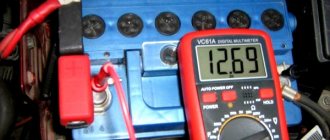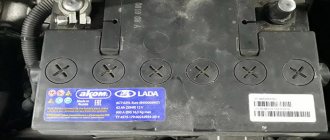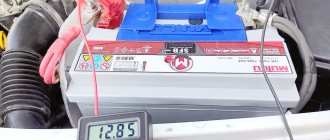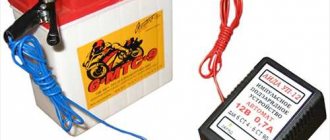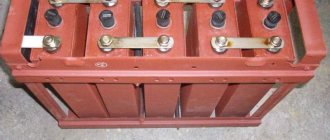Regardless of whether the car has a diesel engine or a gasoline equivalent, the unit requires sufficient energy to start it. A modern car uses electricity not only to enable the starter to turn the flywheel. The on-board system activates many devices and sensors that ensure adequate operation of the fuel system, ignition and other components in the vehicle.
When the car is already started, this current comes from the generator, which uses the engine to generate energy (its drive is connected to the timing belt or timing chain of the power unit). However, to start the internal combustion engine, a separate power source is required, which has a sufficient supply of energy to start all systems. A battery is used for this.
Let's look at what requirements exist for batteries, as well as what you should pay attention to when you need to buy a new car battery.
What does capacity mean?
So, capacity can be called capacity in another way.
That is, to put it simply, it means how much charge the battery can hold. This characteristic is measured in a unit such as ampere-hour (Ah). On the one hand, this unit contains such a measure as “ampere”, indicating the strength of current, and on the other hand, there is also a unit “hour”, which measures time. That is, in simple words, the number of ampere-hours shows the load with what current strength needs to be connected to the battery in order to completely drain it in an hour. But it's not that simple. A battery is a thing that drains faster the more load you connect to it. For example, take a 60 Ah battery. If you connect a small load of 3 A to it, it will sit down in about 20 hours. But if the load is 60 A, then, unfortunately, it will not be able to work for an hour. This dependence was derived by the German scientist Peukert, after whom the corresponding coefficient was named. There is a special formula for calculating the actual capacity of a battery at a particular value of the connected current. We won’t burden you with it here, just take note that there is such a dependence and that’s all.
Well, it probably already became clear to you that the larger the capacity, the longer the device connected to the battery can work on one charge. This primarily applies to gadgets and tools. With cars, you need to consider the situation with capacity from a slightly different angle.
Car battery capacity
In a car, the battery is primarily designed to power the starter, which spins the engine, allowing it to start. Of course, when the engine is turned off, other electrical appliances of the car are powered by the battery. But the main purpose is to power the starter.
To turn the engine crankshaft, a starter of sufficient power is required, which is essentially a conventional electric motor. So, for example, on cars with a 1.3 - 1.6 liter engine, about 1.5 kW of power is required. This means that the current consumption will be about 120 A. Such machines are usually equipped with batteries with a capacity of 55-60 Ah. That is, such a container should ideally be enough to rotate the starter for half an hour. But we noted above that with a high current, the operating time on a single charge is reduced. Plus, we also have winter operation, when a cold battery simply loses its capacity due to low temperatures. It should also be noted that the charging current from the generator while driving is not very high, so even though the battery is somewhat recharged during trips, there is still less charge left in it with each start.
Thus, manufacturers calculated the optimal battery capacity for a given engine size. You can find it out from the car's passport or find it on the Internet specifically for your car. If you buy a battery with a smaller capacity, you will have to charge it quite often. Buying a more capacious battery will allow you to have an additional charge reserve, which is especially useful in winter. But don’t get carried away and take significantly more capacious batteries. The larger the capacity, the lower the internal resistance of the battery. And since the starter is designed to operate with a certain resistance range, using a battery that is too capacious and whose resistance is outside this range can lead to premature failure of the starter.
What is the capacity of the batteries?
Correctly divide the container into 2 types:
- passport or nominal;
- factual or real.
The nameplate capacity is a guideline when purchasing a battery in stores. These characteristics are specified by the manufacturer and reflect the number of Ah under ideal operating conditions.
Optimal conditions mean:
- temperature from 10 to 20 degrees Celsius;
- low or medium humidity;
- full battery charge, etc.
It should be borne in mind that capacity is a variable characteristic. It changes constantly and depends on a number of factors. Therefore, when they write 60 Ah on the power supply housing, this does not mean that the real capacity there is. In most cases it is lower.
It is worth remembering the voltage in the battery. It is determined by summing the voltage in each section of the battery. The standard design includes 6 cans (sections). Under ideal conditions, each generates 2.1 V voltage. In total, this gives 12.6 V. The capacity is also summed up from the characteristics of each can.
Automobile manufacturers usually have a table that states what battery capacity should be installed on a particular car. Moreover, the parameters depend not only on the brand and model. This is influenced by the type of engine, its volume, power, equipment, the presence of certain electrical consumers, etc.
The actual capacity is of great importance for maintaining the performance of the machine. It is measurable. It is necessary to measure how much energy the battery releases when fully charged to the point of discharge. The time during which the current is released is noted and the values are multiplied by each other. That is, the current strength is multiplied by time. Current is in Amperes and time is in hours.
In 99% of cases, the actual capacity will differ from the rated capacity. This is explained by the influence of various internal and external factors on the battery, which is in use or simply stored on a shelf.
During storage, electrochemical processes occur inside. And gradually the battery loses capacity. This is why it is recommended to buy batteries that are no more than 6 months old from their release.
Modern battery standards
Currently, battery sizes are strictly regulated by generally accepted quality standards. We list their main types:
European standard
It is used to produce batteries intended for use in European and our Russian cars (in this case, you should pay attention to the polarity of the terminals, it is usually the opposite). North American standard. The current leads on these batteries are located in the upper part on the side of the housing cover (unlike other batteries, in which the current leads are located along the long side)
The terminals on these batteries are made with internal threads, so finding a similar copy on the Russian market will be very difficult. Most likely, you will have to order the battery directly from the USA, if necessary. Asian standard. The sizes of batteries from Asian manufacturers are fundamentally different from European sizes. Cars produced in Asian countries have much less space under the hood compared to other cars. All engine compartment equipment and the engine are very tightly packed. Asian batteries are much shorter and narrower than competitors, but significantly higher than them.
The dimensions of car batteries may depend not only on the standard, but also on the country of origin. For example, Asian power supplies that are manufactured in Europe for its market may have dimensions similar to European ones. In any case, before purchasing a new power source, you should always carefully study the engine compartment of your car and all the technical nuances associated with its further installation.
Relationship between parameter and energy
A fairly common misconception is that the volume of the battery is considered an indicator that characterizes the energy stored in the battery. The ability to accumulate charge is directly dependent on voltage. Based on this, we can conclude that the higher the battery voltage, the more it is able to accumulate the amount of energy charge. Electrical energy is the multiplication of the charging current, the voltage of the battery itself and the time the current flows. This is all expressed by the equation:
In the example given, the following notation is used:
- W – numerical indicator of accumulated energy, Joule;
- U – battery voltage, Watt;
- I – direct current value, Ampere;
- T — Battery discharge time, hour.
And since the discharge time and constant current give the volume of the battery, another energy formula can be derived:
This formula shows how energy and battery volume are related. If you connect several batteries in series with the same volume value, then the numerical energy value will be presented as the multiplication of the electricity of one element multiplied by the amount in the bundle.
Important! Some battery manufacturers do not indicate the capacity in ampere hours, but show the numerical value of the stored energy in watt hours.
Terminal locations
On a note! There are two options for the location of the charging “pins”: direct (domestic) and reverse (European).
In the first case, the “plus” is on the left, in the second – on the right. Batteries with reverse polarity are used in foreign devices. Terminals may vary in configuration.
European companies produce batteries with a protrusion at the bottom that serves as a support for the latch. Products from the Asian continent are secured on top with a clamping bar.
Indicators affecting capacity
Battery capacity is not a single indicator that is independent. In fact, it directly depends on many battery parameters. These include reserve, energy capacity. They directly affect the nominal value.
We recommend: Windshield wiper blades Ford Focus 2 2005-2010
Energy
A battery indicator such as energy capacity is measured in W/cells. This parameter indicates that the battery is capable of delivering a charge over a certain period of time with constant power. Typically the time span is 1/4 hour or less. This parameter is most popular abroad, but is now gaining popularity in Russia.
In order to approximately calculate the energy capacity of a battery, which is measured in Amp-hour, denoted as Wh, you need to use the formula:
When calculating battery capacity, the following designations are used:
- Q – battery energy capacity obtained during calculations;
- W – battery volume, W/h.
The result is a simple division of the time period. When purchasing batteries, you should look at the designation of its energy capacity.
Reserve
The battery also has one more parameter that characterizes its performance. This includes the battery reserve capacity. As a rule, this parameter is typical for car batteries.
This characteristic indicates that the battery is capable of powering a moving car and its devices at a time when the car’s standard generator is out of order. The reserve is measured in time (minutes) during which the battery is discharged with a current of 25 A.
To calculate the nominal capacity of a battery based on known reserve indicators, use the following formula:
The equation uses the following capacitance notation:
- Q – nominal;
- T – reserve.
Dimensions
Important! The new battery must fit in size into the corresponding compartment in the car. Installing a smaller battery is impractical, since the product will move around the site, which can lead to loss of contact between the terminals and wires.
Placing a larger device is not justified: it is difficult to secure it in a stationary state.
Battery sizes depend on indicators such as capacity and make of car. European manufacturers produce batteries in longer but lower cases, while Asian manufacturers produce batteries closer to a square format.
The standard dimensions of the former (let’s take for example a car battery with a capacity of 60 Ah) are 242 x 175 x 190 mm;
– dimensions of similar batteries from Asia: 232 x 173 x 225 mm.
Factors affecting capacity
Also, the rated capacity may depend on other factors. For example, about discharge current, operating temperature, typical aging, battery wear.
Discharge current
Most of the indicators that are indicated on the battery case from the manufacturer are calculated during test measurements. For example, the discharge current is measured at standard time intervals such as 10, 20 or 100 hours. On the case there will be a corresponding designation of volume Q10, 20 and 100, or discharge current I10, 20 and 100.
And to calculate the current indicator that flows through the load, you simply need to divide the indicator by the number of hours. For example, this way:
But you should not take this as a proportionality of the discharge current and time. They are not proportional quantities. For example, if the battery is discharged in 15 minutes, the current will not be equal to the product of Q20 x 4.
Final discharge voltage
With each discharge cycle, the voltage on the batteries drops, and when the numerical value approaches the final mark, the battery should be disconnected. As a rule, when this limit is reached, the battery simply stops powering the device.
And if the battery is able to continue to power the device at sufficiently low voltage levels, then its volume, as a rule, is much higher than those that turn off at the same level.
Important! If you continue to use batteries at the final discharge voltage, the battery will be deeply discharged. This should not be allowed to happen too often as such conditions contribute to battery wear and eventual failure.
Battery wear
Each battery has a numerical designation on its case indicating its nominal capacity. As a rule, this is a mandatory label from the manufacturer. But the indicated values do not always correspond to actual indicators. The battery may lose its capacity for some reasons. For example, such wear and tear of the battery capacity is typical in such cases as:
- Long-term storage in warehouse;
- Active exploitation;
- Incorrect charging and discharging of the device.
Even simple operation causes the battery to become obsolete. Batteries tend to lose their capacity due to the destruction of the internal plates. For this reason, the battery can no longer absorb the declared amount of energy and provide power to devices for a long time.
We check the quality
We begin the purchase with an external inspection of the battery - there should be no cracks, chips, scratches or other damage to its integrity.
Pay attention to possible oxidation or electrolyte leaks on the body. If there is even the slightest suspicion that the seal of the battery is broken, you cannot buy such a battery. We check the functionality of the new device right on the spot - most specialized stores have load forks that make it easy to check the condition and parameters of the product. A good battery under a load of 150-180 A (twice its capacity) should not show a drawdown below 11 volts. It is in the store's interest to prove that their battery fully meets the minimum requirements, and the service must be provided absolutely free. If the seller wants money for this basic test, it is better to make a better purchase elsewhere.
Buy a car battery that has been in storage for no more than six months. The date of electrolyte filling can be found either on the label, or you will have to decipher the marking on the battery case. The encoding depends on the manufacturer, so you have a direct route to the brand’s website, where all the information should be. All numbers and letters on labels must be easy to read. This is the only way to understand whether this device is original or not.
Reasons for capacity drop
Even the most advanced battery manufacturing technologies do not protect them from loss of performance. That is, loss of capacity is an inevitable phenomenon. It is currently impossible to influence it in any way.
On average, simple lead-acid batteries last 3-4 years. Improved models can last 5-6 years. Occasionally, performance is maintained for 7-8 years.
Several signs indicate loss of capacity:
- the color of the indicator on the body changes;
- when trying to start the engine, the starter clicks;
- the intensity of the headlights decreases;
- The starter functions slowly and spins for a long time before starting the internal combustion engine.
When there is a small charge left in the battery, problems begin from the on-board network. Some consumers are unstable or do not turn on at all.
A decrease in capacity occurs due to several reasons.
- Sulfation. The problem with all lead-acid batteries. This is the name given to the process of the appearance of plaque in the form of lead sulfate. This is an insoluble precipitate. Due to the coating with such a layer, lead plates lose the ability to enter into electrochemical reactions. The amount of restored capacity decreases. Even with long-term charging, it is not possible to restore the charge to 100%.
- Crumbling plates. More often this becomes a consequence of overcharging. Shedding also increases due to a decrease in electrolyte levels.
- Closures When the plates are shorted, the capacitance drops, as well as the voltage. Banks no longer produce 2.1 V. If even 1 section is shorted, the battery will stop working. It is unlikely that you will be able to start the engine. There are two solutions. This is an attempt at restoration or disposal.
Although loss of capacity is inevitable, if you follow the rules for storing and operating the battery, its service life can be significantly increased.
During the period of operation of the battery, it is necessary to periodically check the capacity indicators.
Choice by price
The price of a battery directly depends on the production technology. The newer and more powerful the car battery and the greater its capacity, the more money they will demand for it.
Accordingly, ancient antimony models can be purchased within 2,000 rubles. Hybrid batteries are a little more expensive, costing an average of 2,000-30,000 rubles. Calcium batteries are even more expensive: from 3,000 to 6,000 rubles, if it is a new and original device and not a Chinese counterfeit. The most expensive, but also the highest quality and most powerful batteries are gel and AGM batteries. Their cost varies very widely: from 4,000 to 16,000 rubles per device.
How to check specifications
Now to the question of how you can check the capacity of a car battery, and what tools are required for this.
In fact, there are several ways to determine the capacity and find out the real current characteristics of a battery installed under the hood of a car.
For these purposes, you may need a multimeter, tester, load, etc.
It is worth considering 3 main methods of how to find out the current capacity of a car battery in use:
- using a tester;
- under load;
- control discharge.
Selection by brand
It is better to select a battery not by beautiful labels and advertising, but by reliability and efficiency. For example, look at a special test that is regularly conducted by leading auto publications. There are several battery brands that regularly and successfully participate in such competitions - TAB, Varta, Zver, Tyumen, Aktex and Bosch. It is difficult to say which of them is the best, since the methodology for assessing the quality of calculations is different for everyone.
Battery Testing Standards
There are several standards regulating battery testing procedures depending on their type (IEEE 450 and IEEE 1188 for stationary lead-acid batteries, IEEE 1106 for nickel-cadmium batteries, there are others), but they agree on the main points:
- When installing batteries for the first time, a discharge test (checking the battery capacity) must be performed. They can be carried out by the manufacturer at the production site, who then provides documentation to the customer, or acceptance tests are carried out on site. The more detailed information the manufacturer provides on batteries, the better - with this data it will be possible to compare the results of measurements taken at various stages of operation.
- During the same initial installation period, internal resistance testing of the batteries is performed to determine their baseline parameters. The data is recorded for each battery, in each block, and stored as summary reports for future comparison.
- Procedures 1 and 2 must be repeated at least every 2 years for most systems covered by the warranty - this is usually a condition for continued warranty coverage.
- For most batteries, internal resistance testing should be performed at least once a quarter. In some cases, if specified by the manufacturer, batteries are tested on a yearly cycle, but for most models and types, testing is on a quarterly schedule. Facilities whose work is particularly critical may adopt their own internal regulations, which provide for testing more often, every 1-2 months.
- The test schedule takes into account the full service life of the batteries declared by the manufacturer: measurements must be carried out at least after every 25% of the battery service life.
We recommend: New model URAL
- If a battery has reached 85% of its expected service life, it must be tested for residual capacity at least once a year. The test must be carried out at the same frequency if the capacity drops below 90% of the level declared by the manufacturer (or the difference in readings between previous measurements is more than 10%).
- If the internal resistance test shows a large discrepancy with previous measurement results, it is recommended to perform a residual capacitance test. If the internal resistance drops sharply or exceeds the base value by more than 25%, the battery should be replaced.
- Measurement results must be stored in a clear, organized form. The condition of each battery is monitored according to reports, and if it shows signs of accelerating degradation during the last measurements, the battery must be replaced. Competent reporting allows you to order the right items in the right quantity in advance in order to make replacements on time.
European standard (EN). Capacity at 20 hour discharge.
Used by European and Russian manufacturers of starter batteries. In Russia, the capacity value indicated on the battery case is determined according to GOST 959-91. This figure, in fact, is not the actual, but the nominal capacity of the battery, that is, the capacity with a 20-hour discharge.
To determine the nominal capacity, the battery is continuously discharged with a current of 0.05 of the capacity specified by the manufacturer. The experiment is carried out at a temperature of 25 degrees Celsius until the voltage at the battery terminals drops to 10.V with a constant discharge current.
Thus, if the manufacturer indicated a battery capacity of 60 Ah, then it should consistently deliver a current of 3 Amps for 20 hours until its voltage drops to 10.5V.
American standard (RC). Reserve capacity.
American-made batteries indicate the time (reserve capacity) in minutes during which the battery can deliver a current of 25 Amps at a temperature of 27 degrees Celsius. It is understood that during this time the battery will replace the failed generator and the car will have time to get to the nearest car service center.
Japanese Standard (JIS). Capacity at 5 hour discharge.
Many car owners do not know that in Japan, battery capacitance tests with a discharge current of 1 Ampere are performed with a 5-hour discharge, and not with a 20-hour discharge, as in Europe or Russia. Some people believe that Japanese batteries are “low-power,” although this is not the case.
To bring the capacity value indicated on the body of a Japanese battery to the European standard, you need to multiply it by 1.25. For example, if the battery says 50, then “in our opinion” it is 62.5 (50*1.25 = 62.5).
Manufacturing technology
Lead-Acid (Wet). Liquid lead-acid batteries are most often used as batteries for cars. The positive and negative plates are immersed in a liquid electrolytic composition. A.G.M. Unlike LGC batteries, in AGM batteries the sulfuric acid solution is absorbed by fiberglass cloth. Such batteries are extremely vibration-resistant and can operate in any position. They are recommended for installation in motorcycles, ATVs or cars participating in jeep trial competitions. AGM batteries should also be chosen for cars with the Star-Stop system and powerful audio systems. Due to the low internal resistance of the battery, even with a significant discharge it provides a good starting current. Compared to liquid lead-acid batteries, AGM batteries withstand deep discharges better and therefore have a longer service life. The only disadvantage is, perhaps, the relatively high price. EFB (Enhanced Floded Battery). Batteries use electrolyte in a liquid aggregate state, but the plates with a large amount of purified lead are sealed in a kind of envelope. EFB technology allows you to slow down the rate of oxide deposition, which makes the car battery resistant to deep discharges and extends its service life (with proper operation it can reach 7-9 years). This is the best battery to choose for a car with the Star-Stop system. Oddly enough, EFB batteries are cheaper than AGM batteries. Therefore, if you are not satisfied with the characteristics of Lead-Acid batteries, then it is better to choose Enhanced Floded Battery. GEL. The design of gel batteries allows them to be used only as power sources for motor boats and autonomous power supply for powerful audio systems
Gel batteries have a large capacity, but are not capable of delivering good starting current, which is extremely important for starting the engine in winter.
Low-oxygen, hybrid, calcium batteries
Sb/Sb – marking of low-voltage batteries. The obvious advantages include low cost. If you happen to choose such a battery, you will have to put up with high self-discharge and constantly monitor the density of the electrolytic fluid. If you do not periodically maintain a low-voltage battery, a critical drop in the electrolyte level will lead to exposed plates and a significant reduction in battery life.
Sb/Ca – hybrid car batteries. In all operational characteristics they are superior to low-oxygen batteries.
Ca/Ca – calcium batteries. The active mass of the plates contains a large amount of calcium, which slows down the rate of self-discharge and water evaporation. If you want to choose a car battery with the longest service life, we can recommend a calcium battery. But be prepared to pay a higher price compared to low-voltage and hybrid batteries with similar starting current and capacity.
Which is better: serviced or unserviced?
If the choice of battery is between Lead-Acid and EFB, it is better to refrain from purchasing a maintenance-free battery. But this is by no means the main parameter when selecting. After all, modern calcium batteries have such a low tendency to evaporate water that even without maintenance they are able to start the engine properly for many years. But we recommend serviced batteries for the reason that if the generator relay-regulator malfunctions, you will not have the opportunity to correct the consequences of overcharging.
Capacity, starting current
The description of car batteries indicates the cold cranking current. The higher the TCP, the longer the battery can power the car starter at low temperatures. 3 measurement standards are considered generally accepted: DIN 43559 (GOST 959-91), EN 60095-1 (GOST 959-2002), SSA J537
To choose the right battery, pay attention to the ratio of parameters of different measurement standards. There is no clear relationship between capacitance and starter current, but it is possible to roughly estimate the ratio
Battery capacity indicates how long the battery takes to discharge for a given current draw. The table shows the approximate ratio of the minimum battery capacity to engine size. But in order to choose the right new battery, we recommend that you refer to the repair and operation manual.
Density check
Density is an important indicator. It not only determines what needs to be poured when there is a small amount of liquid inside the battery, but also:
- freezing point of the electrolyte - in the case of extremely low density, such as 1.07 grams per cubic meter. see, it will freeze already at minus 5 degrees Celsius, and at not very low (for example, 1.30) the freezing temperature will be as much as minus 60 degrees;
- battery service life - the higher the concentration of sulfuric acid, the less the battery will last.
Proper battery maintenance involves periodically monitoring the density. This is done using a special device sold in any car store - a hydrometer. The cost of this device is 150 - 200 rubles.
The test must be carried out on a fully charged battery. The hydrometer should show a reading of 1.27 to 1.29 grams per cubic centimeter. Anything below or above this indicator is a deviation from the norm.
Step-by-step instructions on how to check the density of batteries with a hydrometer:
- take the device;
- lower it into each jar one by one;
- draw up the electrolytic solution by pressing the bulb located on top of the device;
- look at the value that the graduated scale will show;
- We determine the average value in mm after taking measurements for all 6 banks.
After the density has been correctly determined, the question of what needs to be filled, and whether it needs to be done at all, will be decided:
- if the density turns out to be increased, then you need to pour distilled water, that is, reduce the concentration of sulfuric acid;
- on the contrary, at lower values, you need to add an electrolyte, that is, increase the concentration of sulfuric acid.
Procedure for adding distilled water
There is nothing complicated in this procedure - just pour a little into each jar. Next, check the level (see above). As soon as it becomes normal, we check the density again.
Adding or Replacing Electrolytic Solution
At low density, you need to add or even completely change the electrolyte in the battery.
What exactly to do depends on what specific concentration of sulfuric acid was determined based on the results of measurements with a hydrometer:
- if from 1.2 to 1.27 grams per cubic centimeter, then the electrolytic solution is added according to the algorithm below (situation No. 1);
- if it is below 1.2 grams per cubic centimeter, then you will have to completely change it (situation No. 2).
To bring the density to normal by adding an electrolyte (situation No. 1), you must:
- pump out as much liquid as possible from each battery can (for example, using a rubber bulb);
- We take electrolyte purchased at a car store and fill each jar with half of the volume that was pumped out using a bulb;
- shake the battery a little, or put a small load on the terminals (for example, connect a car light bulb) - this is necessary so that the added liquid and the liquid already in the battery mix well;
- measure the density - if it does not reach the norm, you must repeat the above steps again.
If the density is extremely low, the entire electrolytic solution will have to be replaced (situation No. 2). This is made more difficult than in the case of adding:
- you need to pump out the solution using a bulb, syringe or other device;
- pour distilled water into jars;
- Rock the battery slightly from side to side;
- pump out flooded water;
- repeat the procedure until the pumped water becomes clear;
- pour new electrolyte from the bottle based on the volume that needs to be poured into the battery of a certain capacity (see table above);
- check the level and density.
Fill rules
The motorist must follow 3 basic rules for filling electrolyte and distilled water:
- the electrolyte level in the battery should be mm above the plate - from 10 to 15;
- if it is necessary to add water, distilled water should be used - pouring water from the tap is strictly prohibited due to the presence of impurities and heavy metal salts in it, which will contribute to the corrosion of lead plates and their oxidation;
- when monitoring readings with a hydrometer, climatic conditions should be taken into account - if the vehicle is operated mainly in northern regions, then the density standard is slightly higher (about 1.30 - 1.31 grams per 1 cubic cm), on the contrary, if the vehicle is used in areas with hot weather , the norm is slightly lower (1.25 - 1.26 grams per 1 cubic cm).
We recommend: Replacing the Hyundai Accent cabin filter: Step-by-step instructions, video
Importance of Density Values
It is important for a motorist to know not only how to check the electrolyte level in batteries, but also to understand why electrolyte concentration is so important:
- increased density contributes to sulfation of the plates and, accordingly, battery failure;
- at low density in winter, in cold weather, the electrolytic solution will simply freeze, since there is a relationship between density and freezing temperature;
- low density, as a rule, may indicate a discharge of the battery - from it it is possible to determine the degree of charge, as well as the voltage at the terminals, based on a special table.
How to choose the right battery capacity for your car?
Typically, this battery parameter is selected according to engine size. Below is a table depending on the engine size of the vehicle.
Battery capacity, AhVehicleEngine capacity, battery capacity, AhVehicleEngine capacity, l
| 55 | cars | 1 — 1,6 |
| 60 | cars | 1,3 — 1,9 |
| 66 | passenger cars (crossovers, SUVs) | 1,4 — 2,3 |
| 77 | light duty trucks | 1,6 — 3,2 |
| 90 | medium duty trucks | 1,9 — 4,5 |
| 140 | trucks | 3,8 — 10,9 |
| 190 | special equipment (excavators, bulldozers) | 7,2 — 12 |
| 200 | trucks (trucks, road trains) | 7,5 — 17 |
As you can see, the most popular for passenger cars are car batteries with a capacity of 50-65 Ah. For SUVs, batteries with a capacity of 70-90 Ah are usually installed. Here it is worth noting a number of points when you should take a battery with a slightly larger capacity:
- if a large number of consumers work in the vehicle’s on-board network (navigation, recorder, security system, TV, various types of heating, etc.);
- if you have a car with a diesel engine (they require a larger battery to start).
A small supply will help out during the cold season. According to the empirical dependence, starting from plus 20 degrees Celsius, with a drop in temperature of one degree, the capacity of a car battery decreases by 1 Ah. So, with a larger capacity you will have a small margin of safety in the cold season.
But remember that too high a value is also “not good”. There are two reasons for this:
- The vehicle's on-board network, including the generator, is designed for certain battery characteristics. Therefore, they may not fully charge a car battery with a larger capacity. As a result of operating in this mode, the battery will lose the advantage of additional capacity;
- The car starter will work at a more intense rhythm. This will affect the wear of the brushes and commutator. After all, the starter is also calculated for certain parameters (starting current, etc.).
We also recommend reading the article about the types of batteries for cars.
How to calculate battery life
To roughly calculate the remaining operating time of the battery under a constant load, for example, a car radio or side lights, you need to know the load current or its power. Since all batteries produce constant voltage and current, simple formulas are used here. The current strength is determined by the formula:
I = P/V,
Where:
- I – current strength (A);
- P – load power (W);
- V – battery voltage (V).
The battery operating time is determined by the formula:
T = Qfact / I,
Where:
- T – operating time of the load from the battery (hour);
- Qfact – actual electrical capacity of the battery at the moment the load is turned on (Ah);
- I – battery load current (A).
The actual electrical capacity of the battery at the moment the load is connected can be determined by the formula:
Qfact = Qrest * 3% /100,
Where:
- Qfact – actual remaining electrical capacity (Ah);
- Qres – residual electrical capacity of a fully charged battery (Ah);
- Z% – charge level in percent (%);
- 100 – conversion of percentages to shares.
The charge level (3%) can be determined from the table by the voltage at the terminals at a temperature of 25 °C.
The voltage value has been rounded to the nearest tenth for ease of remembering. A voltage decrease of 0.1 V corresponds to a 10% decrease in charge.
Expert opinionAlexey BartoshSpecialist in repair and maintenance of electrical equipment and industrial electronics. Ask a question Using formulas, you can calculate how long it will take 4 large 5 W bulbs to discharge a battery that has a residual electrical capacity of 45 Ah and a voltage at the beginning of the discharge of 12.2 V.
The initial discharge current will be: 1.64 A = 20 W / 12.2 V. The actual electrical capacity of the battery will be: 22.5 Ah = 45 Ah * 50% (from the table) / 100. The battery discharge time will be: 13.7 hours = 22.5 Ah / 1.64 A. This means that if you leave the car in the parking lot in the evening with the lights on, you will not be able to start it in the morning. And if the temperature in the morning is near zero, the discharge will occur even faster.
Recommendations
The nominal capacity of the battery means that at a temperature of 25°C, a fully charged battery is discharged with a current equal to 0.05 of the nominal capacity for 20 hours to a voltage of 10.5V at the battery terminals.
It should be noted that discharging to such a state in practice leads to battery failure. Even a discharge up to 11.5 V can lead to a polarity reversal of one of the cans (sections). The fact is that the sections are not discharged at the same time.
This means that the most discharged bank will then begin to take charge from its neighbors. The result is that the plus becomes a minus, and the minus becomes a plus. For this reason, you should not discharge the battery not only to 10.5 Volts, but also to 11.5 V. It is optimal to discharge the battery to a voltage of 12 Volts. In this case, the new battery provides up to 85% of its capacity, without any consequences for the battery itself.
For example, the included dimensions consume 35 Watts or 3A, low beam and dimensions consume 90 Watts or 7.5A. With such a load, a 60Ah battery will run down to a voltage of 12V in 12-13 hours for its dimensions. If you turn on the low beam and dimensions, the battery will discharge to 12V in 4-5 hours.
Let us also add that the battery capacity also greatly depends on the quality class of the battery itself, age, state of charge, general wear and tear, etc. As a rule, if the battery is a year or two old, sulfation of the battery occurs. If such a battery has not been additionally charged or serviced, then a 60Ah battery in reality has a capacity of no more than 4-6 Ah. We also recommend reading the article on how to do battery desulfation yourself. From this article you will learn about the causes of battery sulfation, as well as how to desulfate the battery.
For this reason, it is necessary to periodically maintain the battery, monitor the level and density of the electrolyte, desulfate the battery and properly charge it from external chargers. With this approach, you can increase the service life of the battery by 20-30%, and also avoid the rapid loss of the real capacity of the new battery after 12-18 months of active use.
“Turn the Engine” is dedicated to one of the greatest blessings of civilization - the piston internal combustion engine. Everything about the operation, service and preventative maintenance of gasoline and diesel internal combustion engines. Useful information on engine and attachment repairs, methods and techniques for carrying out diagnostic procedures. Tuning, engine tuning and competent selection of technical fluids.
Sources
- https://yastroyu.ru/tekhnika/2797-na-chto-vliyaet-emkost-akkumulyatora.html
- https://remam.ru/elektrik/kak-proverit-yomkost-akkumulyatora.html
- https://BatteryZone.ru/accumulator/emkost-akkumuljatora
- https://DriverTip.ru/zhizn/kak-proverit-yomkost-akkumulyatora-avtomobilya.html
- https://skomplekt.com/kak_opredelit_ostavshijsya_srok_sluzhby_ostatochnyj_resurs_akkumulyatornoj_batarei_akb/
- https://spb.akb.ru/kak-opredelit-emkost-akkumulyatora/
- https://3batareiki.ru/akkumulyatory/avtomobilnye-akkumulyatory/kakoj-dolzhen-byt-uroven-elektrolita-v-akb-na-50-60-75-190-a-ch-kak-proverit-i-zalit
- https://akbinfo.ru/ustrojstvo/jomkost-avtomobilnogo-akkumuljatora.html
- https://Acums.ru/akkumulyatory/emkost-v-chem-izmeryaetsya-chto-eto-takoe-ostatochnaya-i-rezervnaya-kak-proverit
- https://KrutiMotor.ru/emkost-akkumulyatora-avtomobilya-chto-eto-takoe-i-kakaya-luchshe/

